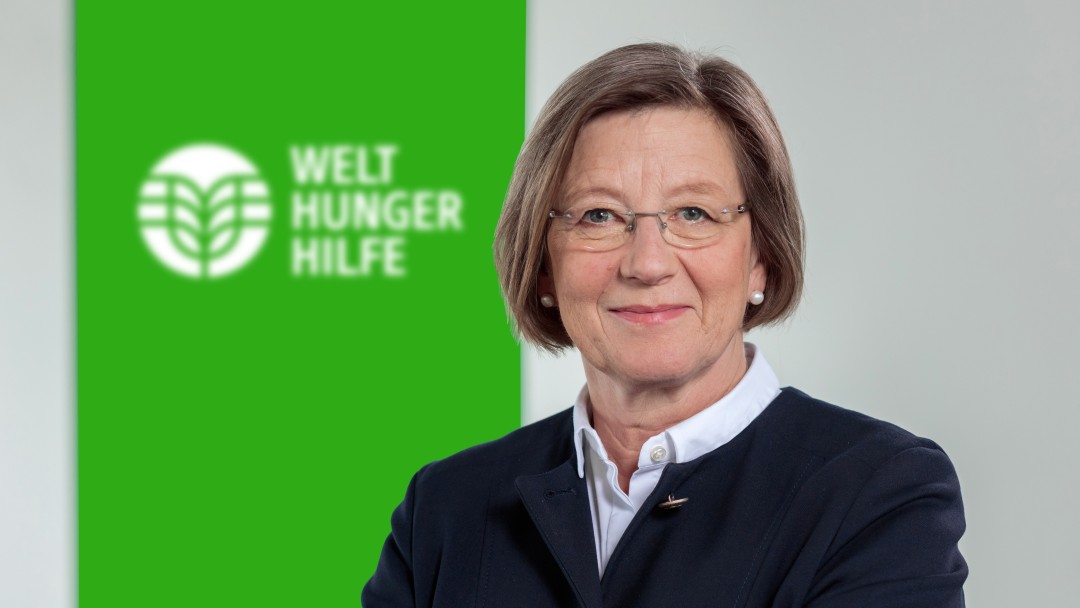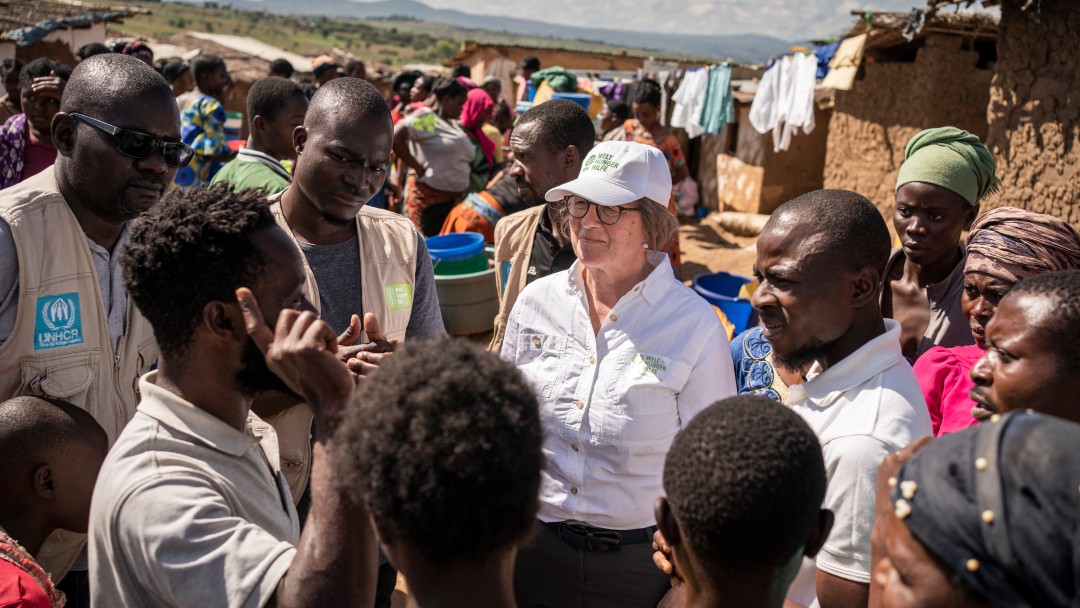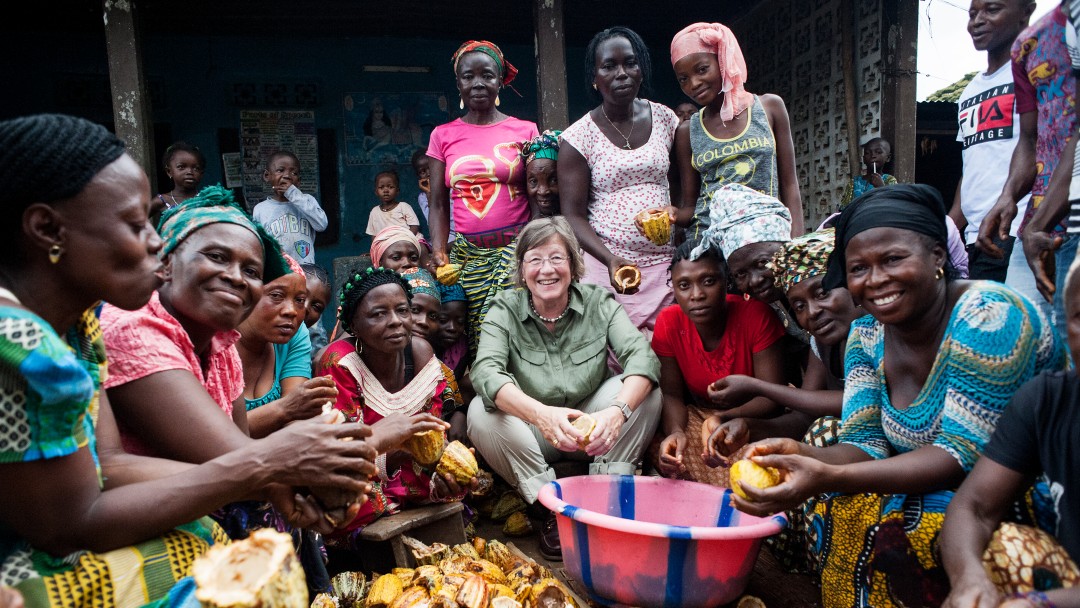INTERVIEW WITH MARLEHN THIEME
“Hunger is a problem that can be solved”Interview with the President of Welthungerhilfe, a non-governmental organisation working locally in countries of the Global South. In the interview, Marlehn Thieme talks to Friederike Bauer about the causes of hunger and what we can do to eliminate it.
Published October 2023, updated October 2024

The commitment of our employees, who act with enormous professionalism and dedication, as well as the experiences and encounters with people locally. Most recently I was in Malawi, and I once again saw the positive effects that can be achieved in the long term.
It was a project to increase agricultural production – with better fertilisation. The principle is simple: the people keep goats that are herded to the fields at a specific time to fertilise the area. They have also learned not to simply grow corn, but also various grains and vegetables such as cucumbers, pumpkins and melons. This means their diet is now more varied. The first goats came from us; the lambs were passed on until everyone had one. The farmers now also receive their own seeds. What’s more, the children are now going to school. It was fantastic to see how so much hope and confidence can be spread with so little funding in one of the poorest countries in the world.
The region in Sub-Saharan Africa. It begins with climate change and its consequences on the Horn of Africa and ends with conflicts and military hostilities in Sudan and South Sudan. This part of the world is clearly our problem child, but Afghanistan, Bangladesh and Syria are also hunger hotspots.
Unfortunately, the war has a severe impact. We were just halfway through the coronavirus pandemic when it broke out. The lack of or drop in exports from Ukraine came at a time when the market for grain and oilseeds was already tense. Transport became more expensive and difficult since the ports were blocked, which particularly affected countries in North Africa and Sub-Saharan Africa. We can see this in the figures for hunger, which unfortunately rose at first and have since stagnated. We are still a long way from Goal 2 of the United Nations’ 17 Sustainable Development Goals (SDGs), which is to end hunger by 2030.

That’s right. The situation used to be worse. Still, we are not on track to achieve the goal to eliminate hunger by 2030. But the problem can be solved. As a global community, we have the expertise as well as the resources. We just need to invest them properly and distribute them fairly.
There is no one way to fight hunger. The conditions vary too much for this: in some parts of the world, there is too much water and flooding. Some areas suffer from drought, others from conflicts, and sometimes it is a combination of the two. In other words, the measures needed to change the living conditions on the ground must always be locally adapted for that specific region. But everywhere there is something you can do. Sometimes retention basins are needed to hold water during rainy seasons. Other places may call for smarter irrigation systems in order to use the scarce water supply as efficiently as possible. In short: It requires concepts that are adapted at local and regional level to help people in their surroundings free themselves from hunger.
We are currently producing enough food. Whether it is enough in the face of an increasing world population depends very much on how we feed ourselves in the future. Less meat saves space and protects biodiversity. If we all eat more plant-based food and waste less – about a third is never consumed – it would be enough to feed ten billion people or more.
Some areas have already been directly hit. For the people on the Horn of Africa, in Madagascar and in Northern Kenya, the effects can be clearly seen and felt. They find it difficult to secure their livelihood there and are sometimes forced to relocate to other areas. In Pakistan, too, where floods have already completely destroyed crops and infrastructure, climate change is not an issue of tomorrow, but has already become a reality. They need adaptation measures now, which also have to be aligned with the local conditions. This is the only possible approach, although it may not be so attractive to international organisations.

Africa could become the world’s breadbasket; the potential is huge. However, the continent is also particularly affected by weather extremes and the consequences of climate change. Its many conflicts don't help either. This is why regionally adapted strategies that incorporate the entire supply chain and take the effects of higher temperatures into account are so important.
I would put it the other way round: areas where governments have shown commitment have been quick to see success. Here it is important to empower people to provide better education so they can farm the land better and become more resilient to the effects of climate change.
It should work as leanly as possible and peel back the bureaucracy: priority for action rather than administration. Longer financing commitments are also important and could certainly be linked to interim objectives. But some projects, especially if they are also intended to bring about a cultural change, need more than the usual three-to-five-year cycle. There's one more thing, and this is aimed more at the German Federal Government: the commitment to food security must not fall victim to a difficult budgetary situation.
In short, we need more funds. This is something that, as responsible taxpayers, we don't like to talk about in these current times, but I think cuts in such a sensitive department are very, very difficult. In addition to the human suffering, hunger is always accompanied by migratory movements. It is in our own long-term interest not to economise here.
Share page
To share the content of this page with your network, click on one of the icons below.
Note on data protection: When you share content, your personal data is transferred to the selected network.
Data protection
Alternatively, you can also copy the short link: https://www.kfw-entwicklungsbank.de/s/enzBwz6c
Copy link Link copied